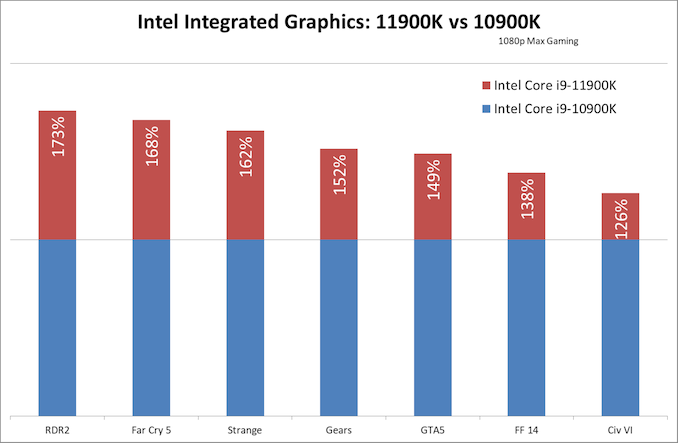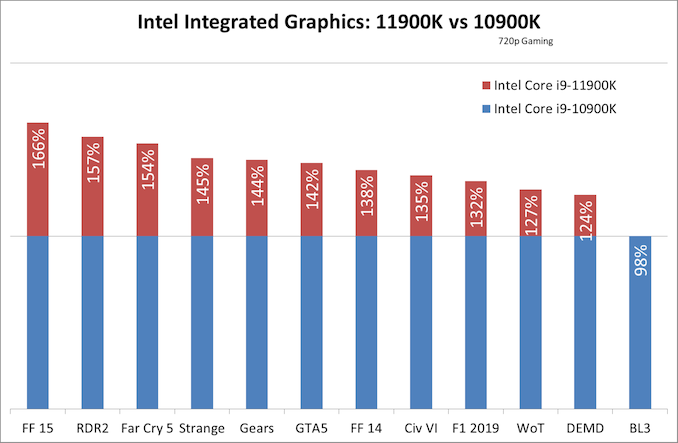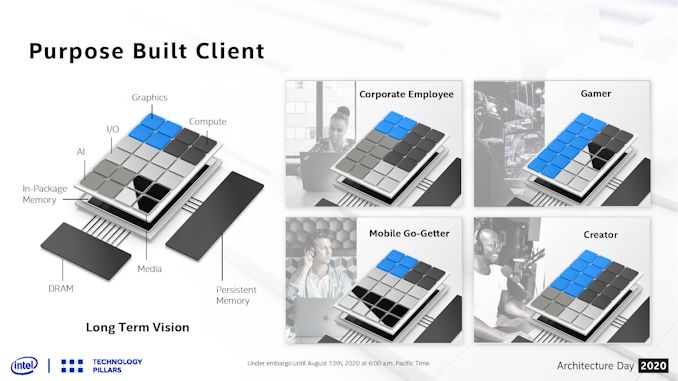Intel’s Integrated Graphics Mini-Review: Is Rocket Lake Core 11th Gen Competitive?
by Dr. Ian Cutress on May 7, 2021 10:20 AM ESTConclusions
No-one ever said that integrated graphics solutions had to be good. Nonetheless there is always the desire for something better, something higher performance, and something suitable for end-users. At the beginning of the era of integrated graphics, the focus was on simply providing something basic for 2D work - applications on an operating system and no real graphics rendering to mention. That solution is simple enough, however the demand on integrated graphics has grown over time, especially as the demands we put on our devices have also grown.
A modern system, especially a commercial system or one designed for work, has to do it all. Anyone not working in graphics might depend on a integrated solution to navigate complex arty web interfaces for the tool they use, or rely upon the acceleration features now baked into those platforms. Also perhaps, from time to time, some mild gaming use as well, if not outright using the compute features of the graphics for transcoding or AI. These demands are most heavily focused on mobile platforms, and as a result mobile platforms from Intel tend to get the best integrated graphics solutions, especially in thin-and-light designs where a discrete graphics solution is too power hungry. Intel's mobile Tiger Lake-U series offers a sizeable 96 execution units of the latest generation graphics architecture, compared to the desktop processors we are testing today, that only have 32.
So what use is a desktop processor with integrated graphics?
AMD and Intel both have product lines with integrated graphics. From Intel, its integrated graphics is in almost everything that Intel sells for consumers. AMD used to be that way in the mid-2010s, until it launched Ryzen, and now we have separate CPU-only and CPU+Graphics options. This is where the company philosophy differs.
AMD's desktop processors with integrated graphics are primarily intended to be a whole system replacement, with users relying on the integrated graphics for all their graphics needs. As a result AMD puts a lot more processing hardware into its integrated graphics solutions for the desktop, and it results in a good gaming experience for entry level gaming.
Intel's route on the otherhand is a bit more basic. The desktop integrated graphics here has two main directions: first, as the basic graphics needed for an office system, or second, more of a fall-back option for when the discrete card doesn't work or fails in more premium desktop systems. The power isn't there for hardcore grunt like gaming of any serious note, but it is certainly enough to cover the basics.
Despite this, with the new Xe-LP graphics solution, Intel has some aces up its sleeve. First is AV1 decoding, which allows users to watch AV1 content without putting stress on the CPU. Second is video encoding accelerationt through QuickSync, which has actually been a part of Intel's graphics for a number of years. Third is a relatively new feature: Intel's 'additional processor' mentality. Normally when a system has a discrete graphics card, the integrated graphics is disabled. But now, with its latest mobile devices for example, when Intel pairs its mobile processor with integrated graphics with a second graphics solution at about the same performance, with the right software Intel allows both graphics to work asynchrouusly on two different problems. The limit to this in the past has been dictating which graphics is the video out rather than simply a compute accelerator, but Intel believes it has worked it out. However, this is relatively little use for gaming, the topic of today.
Results Summary
In this review, we highlighted that Intel has now implemented its new Xe-LP graphics architecture onto its desktop processor line, and tested the new solutions against our traditional CPU gaming test suite. What we saw, in terms of a generational uplift from the i9-10900K to the i9-11900K, is actually quite impressive:
In our 720p testing, there's a clear generational gain across the board for Rocket Lake, and in most cases the games become a lot more playable. The average gain is 39%. If we flip to our gaming results at the higher resolution and settings:

Games with under 10 FPS across the board are left out
For these titles, the average gain is 153%, showing that Xe-LP is certainly a step up regardless of the workload.
The Future of Integrated Graphics
A key talking point about integrated graphics is whether a company should leverage a strong CPU product at the expense of graphics, or aim for something with strong integrated graphics as a more complete chip at the expense of the mid-range graphics market. The console market for example relies fully on integrated graphics designs, especially as it keeps the manufacturing simpler and number of chips lower. But on the desktop space, because discrete graphics are an option (well, when we're not in a mining craze or semiconductor shortage), there seems to be no impetus for companies to do a full fat integrated graphics solution that competes on the same stage as a mid-range graphics card. AMD could do it, but it might overlap with their console agreements, and Intel hasn't done anything serious since Broadwell.
To put a nod to Broadwell, Intel's 5th Gen processor. It was so powerful at integrated graphics at the time, we are still using it today as a comparison point when comparing against other Intel solutions. Broadwell had dedicated 48% of the die area of its top processor to graphics, and for that product it also added some really fast cache memory as well. Intel's focus on integrated graphics as a function of die size has decreased over time, now with Rocket Lake sits at around 20% of the silicon. It hasn't been this low since Intel first introduced its integrated graphics solutions. For that 20%, we get 32 execution units with eight processing cores. Tiger Lake has 96 EUs which total around 33% of overall die size, but has four cores. If Intel was focused on graphics performance in the same way as it was in Broadwell, we might be looking at a 256+ EU solution.
With Intel taking a renewed approach to graphics with its Xe portfolio, stemming from entry up to high performance compute, there is room here for Intel to develop integrated graphics focused solutions. Intel has detailed that it is moving to chiplets with its future mainstream processors under its 'Client 2.0' strategy, and part of that is allowing customers to select how many IP blocks they want of cores, IO, memory, security, and graphics. In the image above, the Gamer option has half of the die area for graphics. This could at the end of the day be a target that could see Intel making desktop integrated graphics a focus again.












165 Comments
View All Comments
GeoffreyA - Monday, May 10, 2021 - link
"the CPU's ideological purist design — pursuing power efficiency too much at the expense of timeefficiency"
Atom may have been terrible, but I respect its design philosophy and Intel's willingness to go back and revive in-order, in the hope it would cut down power considerably. The good designer takes any principle off his shelf to solve a problem and doesn't ban a design because it's old or finished. (Does the good director abandon telling a story through picture because "talkies" took over?) So they decided, why not visit in-order again and see what it can do on a modern process, along with SMT. Out of order, after all, has a lot of overhead.
Spunjji - Tuesday, May 11, 2021 - link
Agreed on respecting the philosophy. With consistent application and a full, coherent vision for the products using it, it could have been quite a neat product.Unfortunately MIDs were always a half-baked idea, and Netbooks appeared to be an excuse for clearing out sub-par components.
GeoffreyA - Wednesday, May 12, 2021 - link
"Netbooks appeared to be an excuse for clearing out sub-par components."Truly. I remember my aunt had one back in 2011, and boy, was that thing junk. Had Windows 7 Basic on it. Not a good impression at all.
mode_13h - Tuesday, May 11, 2021 - link
I think most ARM cores were still in-order, by that point. And that's who Intel was targeting.I hope people aren't too put off by dredging up other ideas that had a couple poor implementations, such as some of the concepts underlying EPIC. I think there's a lot you can do with some of those ideas, other than where Intel went.
GeoffreyA - Wednesday, May 12, 2021 - link
First iterations tend to disappoint. Pentium Pro, another example. I believe we even see the same principle at work in games, software, and the arts.As for EPIC, it did have some interesting ideas. Let's hope they can look past the failure of Itanium and salvage some golden pieces.
mode_13h - Thursday, May 13, 2021 - link
Pentium Pro was brilliant, as long as you weren't running 16-bit code! That's why they branded it as Pro, since I think they figured more business users and prosumers would be using 32-bit apps. Also, it was more expensive, due to its large L2 cache (which was on a separate die).I remember fragging a bunch of noobs in quake, running on a PPro 200 with a T1 line virtually to myself. This was before quake supported 3D cards, and my framerates were definitely above what you'd hit with a regular Pentium. That's pretty much the last time I played games at work, although it was during evenings/weekends.
I tell you, PPro 200 + Matrox Milennium was a brilliant way to run WinNT 3.51 and 4.0.
GeoffreyA - Sunday, May 9, 2021 - link
Some might laugh at this sentiment, but don't be surprised when the desktop microarchitecture starts borrowing tricks from, and is eventually replaced by, the Atom lineage, reminiscent of Dothan/Yonah becoming Core.kepstin - Monday, May 10, 2021 - link
An interesting side effect of the in order design is that these early atom chips are immune to speculative execution vulnerabilities - so they're actually the newest, fastest x86 chips that aren't vulnerable to spectre type issues.I still use an atom D525 based system as my internet router at home, it's fast enough for that for now.
GeoffreyA - Saturday, May 8, 2021 - link
Well, Intel == common sense,does not compute.
CrispySilicon - Friday, May 7, 2021 - link
This is just embarassing. "In all situations, we will be testing with JEDEC memory"I run my 5775C on 1866 DDR3l in XMP, let alone the 2400CL9 1.65v I USED to run in it, and this, is a travesty. Justice for Iris Pro 6200!